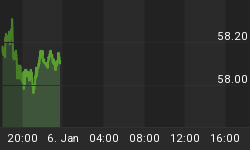We have long warned that stagflation, or economic contraction accompanied by inflation, would become so evident that even the most optimistic observers could not deny its virulence.
Last week, Warren Buffet was the latest to describe his encounter with the beast. The world's most famous investor pronounced that the current economy is in the middle stages of a stagflation episode. Although Mr. Buffet is not typically associated with either bullish or bearish sentiment, he asserted that both the "stag" and "flation" aspects of the condition would intensify before they relent. So if we can all recognize the wolf at the door, can we agree on the best course of action?
Unfortunately for policy makers, different weaponry is called for to vanquish the two heads of the stagflation dragon. Recession can be held at bay by lowering interest rates, while inflation is usually tamed by raising interest rates. Given the impossibility pursuing both courses of action simultaneously, priorities come into play. Historically, inflation has been considered the greater long term economic menace, and has therefore been dealt with first.
This was the plan of attack successfully mapped out by President Reagan and Fed Chairman Paul Volcker in the 1980s. With the President's political backing, Volcker was able to kill stagflation with a short but heavy dose of double-digit interest rates. With the stable currency and low inflation that resulted, the stage was then set for a sustained and robust economic expansion.
Fed Chairman Ben Bernanke has recognized the stagflation threat for some time. But rather than studying the playbook of Volcker and Reagan, his gaze rests on events forty years earlier. A well known student of the financial history the 1930s, Bernanke is well aware that when the same beast raised its head following the Crash of 1929, the Fed rapidly raised interest rates. His conclusion is that this over reaction magnified the recession of 1930 into the Great Depression of the ensuing decade.
Scared stiff that these events could repeat themselves on his watch, Bernanke is loath to push up rates. In so doing, he is ignoring the much more recent and equally instructive lessons of the 1970s, in which a politically cowed Federal Reserve stood by while inflation raged uncontrollably.
Across town, the stagflation reality is gradually dawning on Congress. But, despite calls for higher interest rates from the likes of Mr. Buffet and his peers to strike at inflation first, the reality is that the powerful political influence will be for lower interest rates and more government spending.
However, stagflation is not simply an American concern, and policy makers around the world are showing that their priorities have not been similarly realigned. As the U.S. Fed lowered rates to 2 percent over the past years, the ECB has held firm. Given this difference in priorities, it should come as no surprise that the dollar has plummeted to levels which draw into question its privileged 'reserve currency' status. The Euro, in contrast, has risen to heights that are now hurting European Union exports and causing severe national political strains within the federation.
In this climate, all eyes were turned towards Frankfurt on July 3rd for the ECB's expected rate increase. Although ECB President Jean-Claude Trichet did deliver the increase, he unexpectedly announced that the ECB was putting its series of rate increases on hold. Why had Trichet suddenly gone weak in the knees? Had he been influenced by Bernanke to abandon the Germanic bias to control inflation and to adopt the acute Anglo-Saxon fear of recession?
If the ECB has thrown in the towel, stand by for lower rates, and intensified inflation throughout the world. In the United States, hyper-inflation is a distinct possibility. In such an environment investors should think not only of buying the financial 'insurance' of gold but of devising ways to hang on to it in the face of possible government confiscation, as happened in the 1930s. Given Bernanke's reverence for FDR era policy, such a move is not beyond the realm of possibilities.
For a more in depth analysis of our financial problems and the inherent dangers they pose for the U.S. economy and U.S. dollar denominated investments, read Peter Schiff's book "Crash Proof: How to Profit from the Coming Economic Collapse." Click here to order a copy today.
More importantly, don't wait for reality to set in. Protect your wealth and preserve your purchasing power before it's too late. Discover the best way to buy gold at www.goldyoucanfold.com, download our free research report on the powerful case for investing in foreign equities available at www.researchreportone.com, and subscribe to our free, on-line investment newsletter at http://www.europac.net/newsletter/newsletter.asp.
















